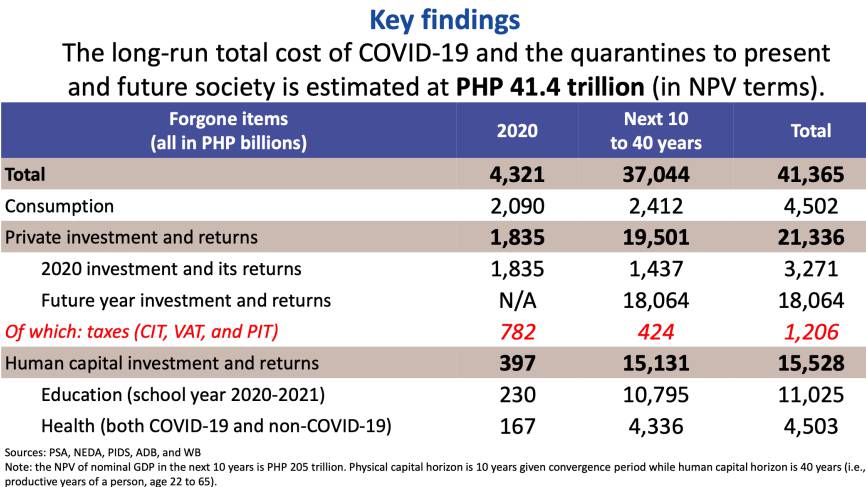The Philippine economy will take a decade to go back to its pre-pandemic growth path due to the lingering effects of the pandemic and the lockdowns, according to the National Economic and Development Authority (Neda).
In a statement on Saturday, Socioeconomic Planning Secretary Karl Kendrick T. Chua said the pandemic and the lockdowns imposed by the government are expected to cost the Philippine economy a total of P41.4 trillion in the next 40 years.

Neda estimated that in 2020, the economy lost P4.3 trillion and is expected to continue to lose another P37 trillion in the next 10 to 40 years.
“We expect the economy to converge to the pre-pandemic growth path by the tenth year. While we will recover to the pre-pandemic level by the end of 2022 or early 2023, it will take several more years before we converge to our original growth path,” Chua said.
The total losses are P4.5 trillion in consumption; P21.34 trillion in private investment and returns; and P15.528 trillion in human capital investment and returns.
Consumption losses are P2.090 trillion in 2020 and P2.412 trillion in the next 10 to 40 years.
Neda data showed that under private investment and returns, the expected losses are composed of P1.835 trillion in 2020 and P19.501 trillion in the next 10 to 40 years.
Of the total private investment and return losses, P3.271 trillion is composed of 2020 investment and its returns; P18.064 trillion in future year investment and returns; and P1.206 trillion in taxes including value-added tax and personal income tax, among others.
In terms of human capital investment and returns, the losses are P11.025 trillion in education investments and P4.503 trillion in health for Covid-19 and non-Covid-19 diseases.
“Over the past six months, NEDA, with assistance from our development partners and attached agencies, has been estimating the total cost of COVID-19 and the quarantines. The present and future costs are estimated at P41.4 trillion in net present value terms,” Chua said.
Lower productivity
Neda said another key finding of the study is that workers’ productivity will also be lower due to untimely death, illness, and lack of face-to-face schooling.
The impact of these on productivity is likely to be permanent over the next 40 years or the average number of years a person is expected to work in his or her lifetime.
Based on the study, the resulting productivity loss in human capital investment and returns is estimated at P15.5 trillion pesos for the next 40 years.
Of this amount, P4.5 trillion are losses due to premature deaths, and the loss in productivity from sicknesses and the inability to access treatment from other diseases and illnesses associated with recovery from Covid-19.
Neda said this also accounts for additional healthcare costs associated with these various diseases and sicknesses.
Meanwhile, the remaining P11 trillion represents the reduction in future wages and productivity, as a result of the suspension of face-to-face classes in school year 2020 to 2021, and the lost wages of parents who forgo or reduce work hours to accompany their children in online classes.
The loss in future wages is based on the impact of lower quality education from online and other types of distance learning during the pandemic.
Neda said the Asian Development Bank, every year of lost schooling leads to a 10 percent permanent decrease in future wages.
Online vs face-to-face: 37% effective
Using US data adjusted for Philippine education levels, NEDA estimates that in the Philippines, online and modular learning is only 37 percent as effective as face-to-face learning.
While this tempers the full impact of total school closures, the prolonged use of distance learning will lead to lower future productivity and consequently lower wages.
“The one-year school closure will cost the economy 230 billion pesos in 2020, and its impact over the next 40 years of the students’ lifetimes in the labor force is estimated at 10.7 trillion. This impact on productivity is likely to be permanent over the person’s lifetime,” Chua explained.
To address the impact of the COVID-19 pandemic and mitigate the long-term scarring effects on the economy and the people, Chua underscored the importance of the three-pillar strategy.
This includes i) accelerating the vaccination program by expanding vaccination sites and leveraging new technologies, ii) opening the economy safely through localized lockdowns and pilot face-to-face classes, and iii) fully implementing the recovery program, especially the 2021 budget.
“Let us use this pandemic to get everyone to work more urgently to address the problems we have now. Our recommendations have not changed. We can still recover to pre-pandemic level by the end of 2022 or early 2023, with a growth rate of 4 to 5 percent this year, and 7 to 9 percent next year, if we do these three things,” Chua said.
Read full article on BusinessMirror
